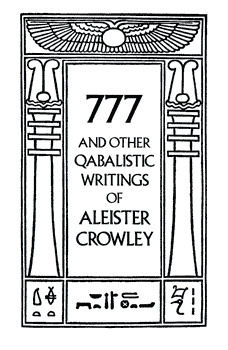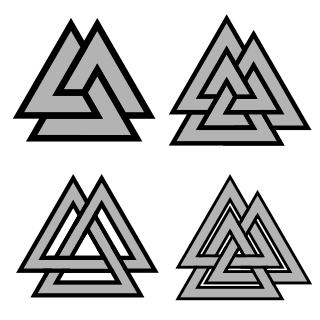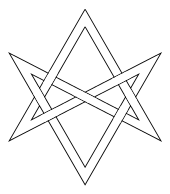
A heptagram, septagram, septegram or septogram is a seven-point star drawn with seven straight strokes.

A pentagram is a regular five-pointed star polygon, formed from the diagonal line segments of a convex regular pentagon. Drawing a circle around the five points creates a similar symbol referred to as the pentacle, which is used widely by Wiccans and in paganism, or as a sign of life and connections.

777 and Other Qabalistic Writings of Aleister Crowley is a collection of papers written by Aleister Crowley. It is a table of magical correspondences. It was edited and introduced by Dr. Israel Regardie, and is a reference book based on the Hermetic Qabalah.
Thaumaturgy, derived from the Greek words thauma (wonder) and ergon (work), refers to the practical application of magic to effect change in the physical world. Historically, thaumaturgy has been associated with the manipulation of natural forces, the creation of wonders, and the performance of magical feats through esoteric knowledge and ritual practice. Unlike theurgy, which focuses on invoking divine powers, thaumaturgy is more concerned with utilizing occult principles to achieve specific outcomes, often in a tangible and observable manner. It is sometimes translated into English as wonderworking.

Ceremonial magic encompasses a wide variety of rituals of magic. The works included are characterized by ceremony and numerous requisite accessories to aid the practitioner. It can be seen as an extension of ritual magic, and in most cases synonymous with it. Popularized by the Hermetic Order of the Golden Dawn, it draws on such schools of philosophical and occult thought as Hermetic Qabalah, Enochian magic, Thelema, and the magic of various grimoires. Ceremonial magic is part of Hermeticism and Western esotericism.

A pentacle is a talisman that is used in magical evocation, and is usually made of parchment, paper, cloth, or metal, upon which a magical design is drawn. Symbols may also be included, a common one being the six-point form of the Seal of Solomon.

A hexagram (Greek) or sexagram (Latin) is a six-pointed geometric star figure with the Schläfli symbol {6/2}, 2{3}, or {{3}}. The term is used to refer to a compound figure of two equilateral triangles. The intersection is a regular hexagon.

The Rose Cross is a symbol largely associated with the legendary Christian Rosenkreuz, a Christian Kabbalist and alchemist said to have been the founder of the Rosicrucian Order. The Rose Cross is a cross with a rose at its centre, which is usually red, golden, or white. It symbolizes the teachings of a Western esoteric tradition with Christian tenets.
In the Zohar, Lurianic Kabbalah, and Hermetic Qabalah, the qlippoth, are the representation of evil or impure spiritual forces in Jewish mysticism, the opposites of the Sefirot. The realm of evil is called Sitra Achra in Kabbalistic texts.
The Bornless Ritual, also known as the Preliminary Invocation of the Goetia or simply Preliminary Invocation, originates from the Graeco-Egyptian Papyri Graecae Magicae (PGM), a collection of ancient spells, invocations, and hymns compiled between the 2nd century BCE and the 5th century CE. Initially used for exorcism and healing, the ritual invokes the "Headless One". In modern times this entity has been re-interpreted as the "Bornless One" without beginning or end, who symbolizes the unity of the divine and the practitioner. Some interpretations suggest that the ritual may have connections with the Egyptian god Set. It is also called the "Headless Rite" or the "Invocation of the Bornless One".

The valknut is a symbol consisting of three interlocked triangles. It appears on a variety of objects from the archaeological record of the ancient Germanic peoples. The term valknut is a modern development; it is not known what term or terms were used to refer to the symbol historically.
Abrahadabra is a significant word within Thelema, received and revealed by Aleister Crowley in The Book of the Law, the central sacred text of Thelema. This magical formula represents the Great Work accomplished—the union of the microcosm (individual) and the macrocosm (universe). It is considered the key to the Aeon of Horus and a word of power that symbolizes the realization of True Will.

Tiferet alternatively Tifaret, Tiphareth, Tifereth or Tiphereth, is the sixth sefira in the kabbalistic Tree of Life. It has the common association of "Spirituality", "Balance", "Integration", "Beauty", "Miracles", and "Compassion".

The tree of life is a diagram used in Rabbinical Judaism in kabbalah and other mystical traditions derived from it. It is usually referred to as the "kabbalistic tree of life" to distinguish it from the tree of life that appears alongside the tree of the knowledge of good and evil in the Genesis creation narrative and well as the archetypal tree of life found in many cultures.
In Thelema, the Abyss represents a metaphysical concept that signifies the great chasm or void separating the manifest world from its divine source. Aleister Crowley, the founder of Thelema, extensively explored and integrated this concept into his esoteric teachings, imbuing it with deep spiritual significance.
Within Thelema, the Great Work is the spiritual endeavor aimed at realizing one's True Will and achieving a profound mystical union with Nuit, the Thelemic personification of the infinite and boundless expanse of the universe. This path, crafted by Aleister Crowley, draws inspiration from Hermetic alchemy and the Hermetic Qabalah. The cornerstone of Thelema is the Book of the Law, received by Crowley in 1904 through a communication with the entity Aiwass. This text became the central scripture, heralding a new Aeon for humanity and outlining the principles of Thelema.

In ceremonial magic, a magical formula or a word of power is a word that is believed to have specific supernatural effects. They are words whose meaning illustrates principles and degrees of understanding that are often difficult to relay using other forms of speech or writing. It is a concise means to communicate very abstract information through the medium of a word or phrase.
In ceremonial magic, banishing refers to one or more rituals intended to remove non-physical influences ranging from spirits to negative influences. Although banishing rituals are often used as components of more complex ceremonies, they can also be performed by themselves. Banishing can be viewed as one of several techniques of magic, closely related to ritual purification and a typical prerequisite for consecration and invocation.

In mathematical knot theory, 74 is the name of a 7-crossing knot which can be visually depicted in a highly-symmetric form, and so appears in the symbolism and/or artistic ornamentation of various cultures.














